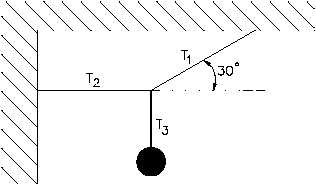F1
F2
F3
0
'
F
0
'
FX
0
'
FY
0
'
FZ
0
Application of Newton's Laws
FORCE EQUILIBRIUM
Rev. 0
Page 13
CP-04
Figure 6 Hanging Object
The first condition of equilibrium, a consequence of Newton's first law, may be written in
vector form, "A body will be in translational equilibrium if and only if the vector sum of forces
exerted on a body by the environment equals zero."
For example, if three forces act on a body it is necessary for the following to be true for the
body to be in equilibrium.
(4-3)
This equation may also be written as follows.
(4-4)
This sum includes all forces exerted on the body by its environment. The vanishing of this
vector sum is a necessary condition, called the first condition of equilibrium, that must be
satisfied in order to ensure translational equilibrium. In three dimensions (x,y,z), the component
equations of the first condition of equilibrium are:
(4-5)
This condition applies to objects in motion with constant velocity and to bodies at rest or in
static equilibrium (referred to as STATICS).
Applying the knowledge that an object in equilibrium has a net force equal to zero, the
following example can be solved:
Example:
The object in Figure 6 has a
weight of 125 lbf. The object
is suspended by cables as
shown. Calculate the tension
(T ) in the cable at 30- with
1
the horizontal.

